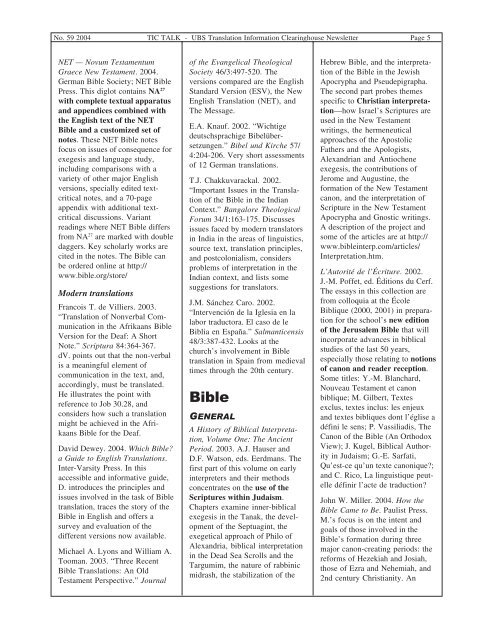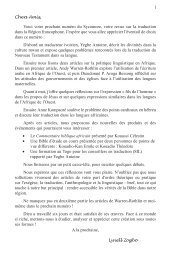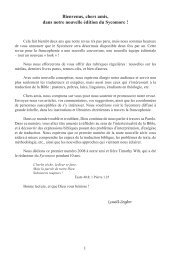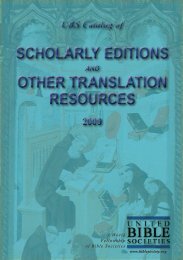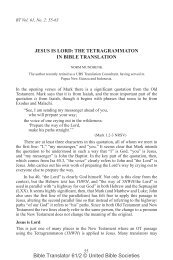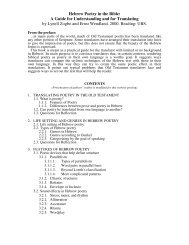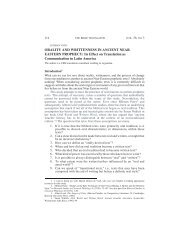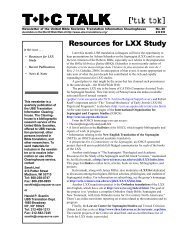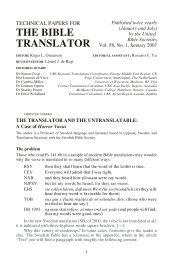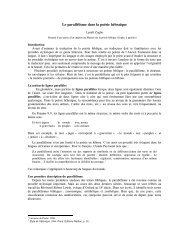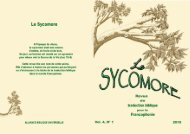TIC Talk - UBS Translations
TIC Talk - UBS Translations
TIC Talk - UBS Translations
Create successful ePaper yourself
Turn your PDF publications into a flip-book with our unique Google optimized e-Paper software.
No. 59 2004<strong>TIC</strong> TALK - <strong>UBS</strong> Translation Information Clearinghouse Newsletter Page 5NET — Novum TestamentumGraece New Testament. 2004.German Bible Society; NET BiblePress. This diglot contains NA 27with complete textual apparatusand appendices combined withthe English text of the NETBible and a customized set ofnotes. These NET Bible notesfocus on issues of consequence forexegesis and language study,including comparisons with avariety of other major Englishversions, specially edited textcriticalnotes, and a 70-pageappendix with additional textcriticaldiscussions. Variantreadings where NET Bible differsfrom NA 27 are marked with doubledaggers. Key scholarly works arecited in the notes. The Bible canbe ordered online at http://www.bible.org/store/Modern translationsFrancois T. de Villiers. 2003.“Translation of Nonverbal Communicationin the Afrikaans BibleVersion for the Deaf: A ShortNote.” Scriptura 84:364-367.dV. points out that the non-verbalis a meaningful element ofcommunication in the text, and,accordingly, must be translated.He illustrates the point withreference to Job 30.28, andconsiders how such a translationmight be achieved in the AfrikaansBible for the Deaf.David Dewey. 2004. Which Bible?a Guide to English <strong>Translations</strong>.Inter-Varsity Press. In thisaccessible and informative guide,D. introduces the principles andissues involved in the task of Bibletranslation, traces the story of theBible in English and offers asurvey and evaluation of thedifferent versions now available.Michael A. Lyons and William A.Tooman. 2003. “Three RecentBible <strong>Translations</strong>: An OldTestament Perspective.” Journalof the Evangelical TheologicalSociety 46/3:497-520. Theversions compared are the EnglishStandard Version (ESV), the NewEnglish Translation (NET), andThe Message.E.A. Knauf. 2002. “Wichtigedeutschsprachige Bibelübersetzungen.”Bibel und Kirche 57/4:204-206. Very short assessmentsof 12 German translations.T.J. Chakkuvarackal. 2002.“Important Issues in the Translationof the Bible in the IndianContext.” Bangalore TheologicalForum 34/1:163-175. Discussesissues faced by modern translatorsin India in the areas of linguistics,source text, translation principles,and postcolonialism, considersproblems of interpretation in theIndian context, and lists somesuggestions for translators.J.M. Sánchez Caro. 2002.“Intervención de la Iglesia en lalabor traductora. El caso de leBiblia en España.” Salmanticensis48/3:387-432. Looks at thechurch’s involvement in Bibletranslation in Spain from medievaltimes through the 20th century.BibleGENERALA History of Biblical Interpretation,Volume One: The AncientPeriod. 2003. A.J. Hauser andD.F. Watson, eds. Eerdmans. Thefirst part of this volume on earlyinterpreters and their methodsconcentrates on the use of theScriptures within Judaism.Chapters examine inner-biblicalexegesis in the Tanak, the developmentof the Septuagint, theexegetical approach of Philo ofAlexandria, biblical interpretationin the Dead Sea Scrolls and theTargumim, the nature of rabbinicmidrash, the stabilization of theHebrew Bible, and the interpretationof the Bible in the JewishApocrypha and Pseudepigrapha.The second part probes themesspecific to Christian interpretation—howIsrael’s Scriptures areused in the New Testamentwritings, the hermeneuticalapproaches of the ApostolicFathers and the Apologists,Alexandrian and Antiocheneexegesis, the contributions ofJerome and Augustine, theformation of the New Testamentcanon, and the interpretation ofScripture in the New TestamentApocrypha and Gnostic writings.A description of the project andsome of the articles are at http://www.bibleinterp.com/articles/Interpretation.htm.L’Autorité de l’Écriture. 2002.J.-M. Poffet, ed. Éditions du Cerf.The essays in this collection arefrom colloquia at the ÉcoleBiblique (2000, 2001) in preparationfor the school’s new editionof the Jerusalem Bible that willincorporate advances in biblicalstudies of the last 50 years,especially those relating to notionsof canon and reader reception.Some titles: Y.-M. Blanchard,Nouveau Testament et canonbiblique; M. Gilbert, Textesexclus, textes inclus: les enjeuxand textes bibliques dont l’église adéfini le sens; P. Vassiliadis, TheCanon of the Bible (An OrthodoxView); J. Kugel, Biblical Authorityin Judaism; G.-E. Sarfati,Qu’est-ce qu’un texte canonique?;and C. Rico, La linguistique peutelledéfinir l’acte de traduction?John W. Miller. 2004. How theBible Came to Be. Paulist Press.M.’s focus is on the intent andgoals of those involved in theBible’s formation during threemajor canon-creating periods: thereforms of Hezekiah and Josiah,those of Ezra and Nehemiah, and2nd century Christianity. An


